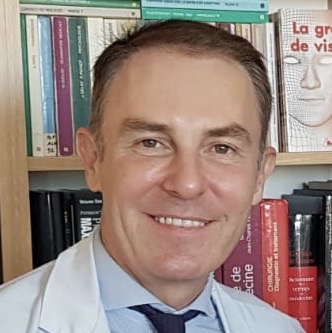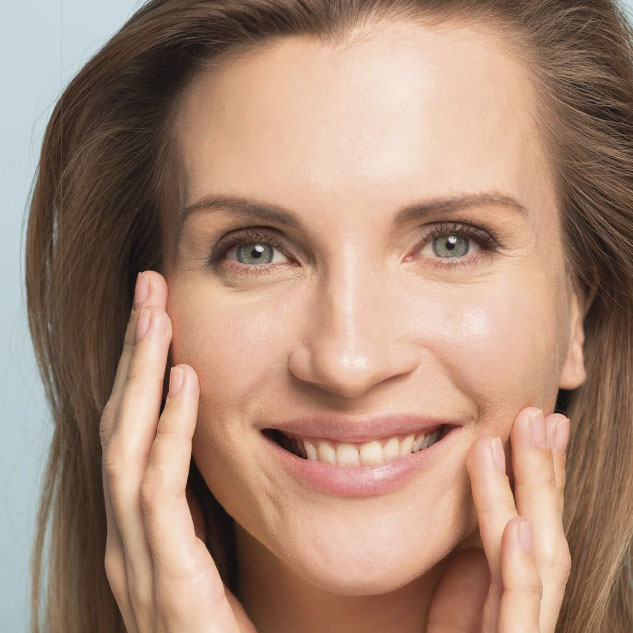Our appearance, particularly our face, is closely correlated with our chronological age.
Pr Jean Paul Meningaud
Worrying about one’s appearance might seem futile. In fact, many intellectuals, psychologists, organ specialists, religious people and teachers consider physical hang-ups to be trivial. But, as a specialist in facial surgery, I have noticed how much suffering a patient’s appearance can cause them, whether their face has been mutilated in an accident or if it has simply been affected by the passing of time. Aesthetic medicine and cosmetic surgery allow us to take control of our physical appearance and our health, without any dogmatism. I am convinced that our beauty lies in our diversity.
Our appearance correlates with our chronological age
 We are the same age as our arteries, our mental performance, our hormone levels, our chromosomes, and our external appearance. Our appearance, particularly our face, is intricately connected with our chronological age. My team was able to verify this in a recent study. Subconsciously, we are all able to estimate a person’s age fairly accurately but, if we receive a minimum amount of training in the objective criteria of facial aging, our accuracy increases exponentially. From this, we can deduce that, at any given moment, an effective anti-aging treatment must end up favourably altering our appearance. This treatment, if it is effective, will not just alter our biological parameters or stress levels, it will also have an influence on our outer shell.
We are the same age as our arteries, our mental performance, our hormone levels, our chromosomes, and our external appearance. Our appearance, particularly our face, is intricately connected with our chronological age. My team was able to verify this in a recent study. Subconsciously, we are all able to estimate a person’s age fairly accurately but, if we receive a minimum amount of training in the objective criteria of facial aging, our accuracy increases exponentially. From this, we can deduce that, at any given moment, an effective anti-aging treatment must end up favourably altering our appearance. This treatment, if it is effective, will not just alter our biological parameters or stress levels, it will also have an influence on our outer shell.
Aesthetic medicine and cosmetic surgery have a positive impact on our health
It has been well proven that procedures that alter our appearance can have a positive impact on specific aspects of our health: posture, chronic pain (neck and back), stopping smoking, adopting a healthier lifestyle (losing weight, diet, exercise, which affects blood sugar levels), respiratory function and field of vision. The advantages of aesthetic medicine and surgery have not just been proven on a physical level: anxiety, quality of life, self-esteem, self-confidence and sexuality. We can also ask ourselves if taking direct action on our appearance, and therefore on our psyche, has an influence on the biological parameters of aging. Can changing our outer appearance be seen as “cheating” or does it bring about a positive feedback loop, i.e. a mechanism of positive reinforcement on our general state of health? Several arguments point towards this positive feedback loop.
The indirect infl uence of aesthetic medicine and surgery
First of all, there is a general rule that says that life is made up of a set of systems that have long been in a state of equilibrium. At molecular level, this is expressed by biochemical equations that allow for a slight step backwards with negative feedback loops (braking mechanism) or positive feedback loops (reinforcement mechanism). The hypothesis of a positive feedback loop, with the appearance overcoming biology, seems coherent with the laws of nature. Furthermore, it has been shown that improving psychological aspects such as anxiety, self-confidence or self-esteem might have an influence on the secretion of stress hormones. It has even been reported that body language can alter hormone secretion. A team from Columbia University reported that a simple change in body language can increase testosterone levels and reduce cortisol levels, and in less than 2 minutes. Using a panel of volunteers, this team measured the levels of testosterone and cortisol in the saliva of participants who were either in a submissive position (hunched up, arms and legs crossed, head hanging) or a more confident position (arms open, head held high, straight back, etc.). The methodology of this work was disputed, however. Nevertheless, we can put forward the hypothesis that medical or surgical procedures that boost self-confidence for the long term can have an effect on the chronic production of these hormones, and therefore on other biological processes involved in aging.
The direct influence of aesthetic medicine and surgery
We now know that a great many new techniques in aesthetic medicine and surgery have a positive biological effect on the tissues they target. For example, a straightforward injection of hyaluronic acid has a local tissue inducing effect (regenerating), which increases collagen synthesis, for example. In surgery, the lipofilling technique (injecting the patient’s own fat) enhanced with platelet-rich plasma can have an astonishing tissue inducing effect. What is more, effects can even be noticed in areas other than the treatment area (paracrine effects, for example). Anti-aging medicine and procedures that alter our appearance certainly influence one another but, if we address both at the same time, they have a synergetic effect on one another. The most important thing is not to cause harm, primum non nocere. This is part of the Hippocratic oath and is a timeless principle. To achieve their aim, these medical procedures should be carried out by fully-qualified doctors and the indications should be set out in a rational way.
Références : 1. La Padula S, Hersant B, SidAhmed M, Niddam J, Meningaud JP. Objective estimation of patient age through a new composite scale for facial aging assessment: The face – Objective assessment scale. J Cra-niomaxillofac Surg. 2016 Jul;44(7):775-82. 2. Sá PO et al. The Effect of Reduction Mammaplasty on Body Posture: A Preliminary Study. Plast Surg Nurs. 2020;40(1):29-34. 3. Chao JD et al. Reduction mammaplasty is a functional operation, improving quality of life in symptomatic women: a prospective, single-center breast reduction outcome study. Plast Reconstr Surg. 2002;110(7):1644-1654. 4. Van Slyke AC et al. Perioperative and Long-Term Smoking Behaviors in Cosmetic Surgery Patients. Plast Reconstr Surg. 2017;140(3):503-509. 5. Narsete T et al. Large-volume liposuction and prevention of type 2 diabetes: a preliminary report. Aesthetic Plast Surg. 2012;36(2):438-442. 6. Zoumalan RA et al. Subjective and objective improvement in breathing after rhinoplasty. Arch Facial Plast Surg. 2012;14(6):423-428.7. Hollander MHJ et al. Functional outcomes of upper eyelid blepharoplasty: A systematic review. J Plast Reconstr Aesthet Surg. 2019;72(2):294-309.
 Pr Jean Paul Meningaud : Professor at the University of Paris 12 since 2009. Head of the Plastic, Reconstructive, Aesthetic and Maxillofacial Surgery department at Henri Mondor University Hospital since 2012. Former junior doctor at the Paris Hospitals. Former registrar at Salpêtrière Hospital. Legal expert for the Paris Court of Appeals and recognised by the Court of Cassation. A face specialist, he has worked on 7 face transplants since 2007. A doctor of science, he dedicates a signifi cant amount of time to research and publishes around twenty scientifi c articles per year, namely in the fi elds of surgery and aesthetic and anti-aging medicine. In 2011, he received one of the greatest distinctions available in plastic surgery, the James Barret Brown Award in the United States, for his work on removing grafts for face transplants. He was chairman of the EACMFS from 2018 to 2020. He created nine university diplomas which have become benchmarks in the fi eld of aesthetic medicine. He is a full member of the French National Academy of Surgery.
Pr Jean Paul Meningaud : Professor at the University of Paris 12 since 2009. Head of the Plastic, Reconstructive, Aesthetic and Maxillofacial Surgery department at Henri Mondor University Hospital since 2012. Former junior doctor at the Paris Hospitals. Former registrar at Salpêtrière Hospital. Legal expert for the Paris Court of Appeals and recognised by the Court of Cassation. A face specialist, he has worked on 7 face transplants since 2007. A doctor of science, he dedicates a signifi cant amount of time to research and publishes around twenty scientifi c articles per year, namely in the fi elds of surgery and aesthetic and anti-aging medicine. In 2011, he received one of the greatest distinctions available in plastic surgery, the James Barret Brown Award in the United States, for his work on removing grafts for face transplants. He was chairman of the EACMFS from 2018 to 2020. He created nine university diplomas which have become benchmarks in the fi eld of aesthetic medicine. He is a full member of the French National Academy of Surgery.
More infos: meningaut.com













